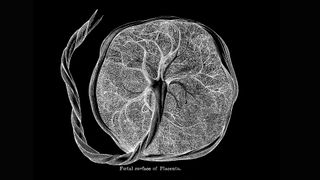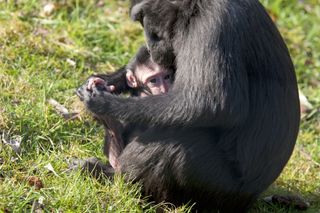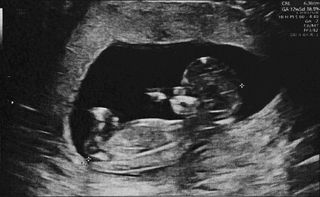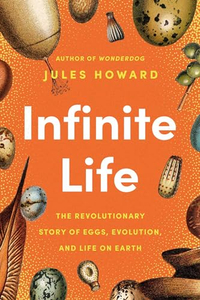'I have never written of a stranger organ': The rise of the placenta and how it helped make us human
"Human evolution has occurred both due to, and in spite of, the placenta. Every pregnancy, unthinkingly, must navigate a careful path through it. Every menstruation is testament to it. It is partly why menopause exists, to give individuals an escape from the energetic costs associated with its imposition."

In this adapted excerpt from "Infinite Life: The Story of Eggs, Evolution, and Life on Earth," (Pegasus Books, 2024) author Jules Howard examines the invasiveness of the placenta — how far it permeates into the wall of the uterus and the maternal tissue — in mammals after the dinosaur-killing asteroid struck.
Although it has not been preserved in the fossil record, the diversity of placentae among modern-day mammals suggests that, about 10 or 20 million years after the end-Cretaceous, at around the time that the animals of the Messel Pit were alive, the mammal placenta was changing. Natural selection was tweaking this organ.
In many cases, it was selecting the individual placentae best able to extract as much energy from the maternal host as possible. Yet, surprisingly, in some lineages the placenta appeared to take a step back, becoming less, rather than more, invasive. Looking at data across 60 mammal species, a trend becomes apparent.
Plotting the invasiveness of each placenta (judged partly by how many blood- gathering, finger-like projections the placenta has) against important life-history details, such as how long a species takes to mature and how many offspring each year a species might produce, the least invasive mammal placentae are those associated with a more rapid pace of life.
Species that live fast and die young, in other words, appear to end up evolving a less invasive placenta.
Brain size is another marker that tracks closely with how invasive a placenta evolves to be. Not just how large the brain is in relation to the body, but also how quickly the brain grows before birth. Both factors correlate with especially invasive placentae. How it works is simple: The bigger a mammal’s brain evolves to be, the greater selective force is placed on the placenta to acquire energy for the growth of the embryo, which, naturally, drives the evolution of an ever-hungrier placenta.
Mammals are, as a group, more brainy than other similar sized organisms, but this wasn’t always as key a feature of our kind. It seemed to happen gradually, after the demise of dinosaurs and as the Cenozoic Era (66 million years ago to the present) began to progress. Scientists had originally thought that this relative increase in brain size was simply a byproduct of the evolution of larger body size in mammals, but recently (using three-dimensional models of fossilized mammal skulls) this assumption has been more rigorously tested.
Sign up for the Live Science daily newsletter now
Get the world’s most fascinating discoveries delivered straight to your inbox.
At first, it seems, in the 10 million years after the era-ending meteorite, mammal body size increased and, relatively, so too did brain size. But then, clearly visible at fossil sites like Messel, brain size in certain lineages increases at a higher than expected rate compared to body size. Mammal brains, in some lineages, were given a metaphorical shot in the arm. So why? If they cost both mother and fetus more to produce, particularly in the embryo stage, what’s so good about big brains?
The researchers who first made this observation about brain sizes in mammals, comparing three-dimensional models of fossilized skulls, think that this trend occurred because of competition. At first — without dinosaurs and other large land animals — plants, insects and other resources were easy to harvest and competition between individuals was low. In this environment, energy-sapping brains were costly and unnecessary.
But later, when mammals diversified and established themselves — when there was more competition for niches, for food and resources — smarter individuals were comparatively more successful in some species. In terms of the transmission of genes, large brains began to pay out and, in some lineages, bigger and better brains started to evolve. In some mammalian groups today, such as dolphins, rodents and particularly primates (monkeys and apes), the ratio of brain size to body size has continued to increase with time. In humans, perhaps the wiliest of all primates, the trend continued with aplomb.

There is no denying the selection pressure at work here: big brains really are inordinately expensive for bodies to build. And human brains truly differ from the brain of our nearest relatives, the chimpanzees (Pan troglodytes). At birth, for instance, a chimpanzee’s brain is 130 cubic centimeters (8 cubic inches) and then triples in size in the following three years.
Compare that to the human brain. At birth, the human brain is more than twice the size of a chimpanzee's and, in six years, it quadruples in size. Although our brain takes up just 2% of our total body weight, this organ consumes between 20% and 25% of our resting energy budget. The human brain costs something like 420 calories a day to run, four times more than the chimpanzee's brain.
This is why the relationship between human mother and child, connected via the placenta, has become, evolutionarily, so strained in our species. More strained, it seems, than in any other mammal.
Liam Drew, author of the authoritative "I, Mammal" (Bloomsbury Sigma, 2018) points out exactly how twisted this relationship becomes. For starters there's preeclampsia, when the mother's body goes through a life-threatening surge in blood pressure as the human fetus increases the rate of blood flow through the placenta.
Put simply, it wants to be bathed in as much life-giving blood as possible. And there's gestational diabetes, caused by the fetus' attempt to co-opt maternal control of blood sugars — predictably, it wants more than the mother is able to give.

Preeclampsia affects about 5% of human females carrying a single baby to term. Add more offspring into the mix, twins or triplets say, each of whom will often have their own placenta, and preeclampsia rates increase to one in three pregnancies. This makes childbirth a risky activity for human females.
There are other tricks that the placenta has evolved to get what it needs for the embryo. Staggeringly, we now know that the placenta uses a special protein (called PP13) to inflame the tissue around tiny veins in the uterus, causing the mother's immune system to invest heavily in immune defenses. It's a classic distraction technique evolved by the placenta: If the mother's immune system is firefighting elsewhere, it is less likely to focus its attention on combating the placenta's active uterine encroachments.
What results from all of this, says Cat Bohannon, author of "Eve: The Real Origin of Our Species" (Knopf, 2023) is a "nine-month stalemate": "women's bodies are particularly adapted to the rigors of pregnancy not simply so we can get pregnant but so we can survive it," she writes.
The highly invasive human placenta, influenced by our enormous brain and (probably to a lesser extent) our slow-and-steady life history, also explains another quirk of our species, the phenomenon of menstruation. This adaptation is fleetingly rare among mammals, found only in some primates, bats and elephant shrews. In humans, menstrual bleeding is particularly overt and, by now, after reading the previous paragraphs, you can probably guess why.
Having an extra-thick uterine lining helps the female survive the potentially hostile tentacle-like villi of the placenta, should pregnancy occur. The lining of the uterus in our species has become so thick that we cannot possibly reabsorb it every few days or weeks, as other mammals do. It is more efficient, in our species at least and a handful of others, to shed the uterine armament and grow it afresh each cycle ready for the next potential implantation.
And so, human evolution has occurred both due to, and in spite of, the placenta. Every pregnancy, unthinkingly, must navigate a careful path through it. Every menstruation is testament to it. It is partly why menopause exists, to give individuals an escape from the energetic costs associated with its imposition. This life-history phenomenon only exists in a small number of apes and some whales and dolphins.
In many years of writing about the insides and outsides of animals, I confess I have never written of a stranger organ or a weirder evolutionary contract. I find myself quietly saluting the placenta that fought for me in my earliest moments, while simultaneously feeling apologetic to the maternal host in which I grew. This is a world-changing adaptation, in more ways than one.
Disclaimer
Excerpted from "Infinite Life: The Story of Eggs, Evolution, and Life on Earth" by Jules Howard. Published by Pegasus Books, Sept. 3,, 2024.
Infinite Life: The Revolutionary Story of Eggs, Evolution, and Life on Earth — $21.27 on Amazon
Infinite Life: The Revolutionary Story of Eggs, Evolution, and Life on Earth, offers a wholly new perspective on the animal kingdom, and, indeed, life on Earth. By examining eggs from their earliest histories to the very latest fossilized discoveries — encompassing the myriad changes and mutations of eggs from the evolution of yolk, to the hard eggshells of lost dinosaurs, to the animals that have evolved to simultaneously give birth to eggs and live young — Howard reveals untold stories of great diversity and majesty to shed light on the huge impact that egg science has on our lives.

Jules Howard, author of Wonderdog, is a wildlife expert, zoology correspondent, science-writer, and broadcaster. He writes regularly for many publications, including the Guardian, and appears regularly on television in the United Kingdom. He is the author of several nonfiction books and lives in London.
Most Popular


